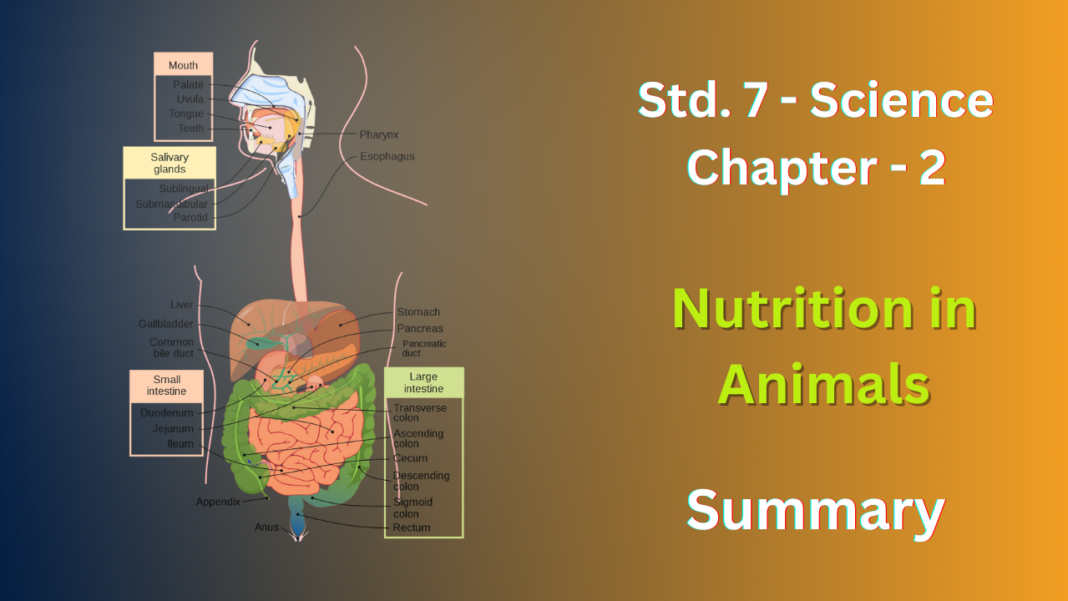NCERT Solutions for class 7 Science Chapter 2
Animals, unlike plants, can’t make their own food.
Getting Food:
- Animals obtain food in various ways, depending on what they eat.
- Herbivores eat plants.
- Carnivores eat other animals.
- Omnivores eat both plants and animals.
- They use various body parts to acquire food, like teeth for chewing, claws for catching prey, or beaks for pecking.
Food Processing:
- After consuming food, animals use digestion to convert it into a usable form.
- This process involves:
- Ingestion: Taking food into the body (mouth).
- Digestion: Breaking down food into simpler molecules using enzymes (stomach and intestine).
- Absorption: Passing the broken-down nutrients into the bloodstream (small intestine).
- Assimilation: Using nutrients for energy, growth, and repair throughout the body.
- Egestion: Removing undigested food waste (elimination).
Importance of a Balanced Diet:
- Just like us, animals need a balanced diet containing carbohydrates, proteins, fats, vitamins, and minerals for proper functioning and growth.
- The amount and type of food animals require vary based on their activity and lifestyle.
Remember:
- This process of obtaining food and using its nutrients is essential for all animals to survive and thrive.
NCERT Solutions for class 7 Science Chapter 2
Q.1.Fill in the blanks:
(a) The main steps of nutrition in humans are ___________, ___________, ___________ , ___________ and ___________
(b) The largest gland in the human body is ___________.
(c) The stomach releases hydrochloric acid and ___________ juices which act on food.
(d) The inner wall of the small intestine has many finger-like outgrowths called ___________
(e) Amoeba digests its food in the ___________ .
Ans.(a) ingestion, digestion, absorption, assimilation, egestion
(b) liver (c) digestive (d) villi (e) food vacuole.
Q.2. Mark ‘T’ if the statement is true and ‘F’ if it is false:
(a) Digestion of starch starts in the stomach.
(b) The tongue helps in mixing food with saliva.
(c) The gall bladder temporarily stores bile.
(d) The ruminants bring back swallowed grass into their mouth and chew it for sometime.
Ans. a) False
(b) True
(c) True
(d) True
Q.3.Tick (S) mark the correct answer in each of the following: NCERT Solutions for class 7 Science Chapter 2
(a) Fat is completely digested in the
(i) stomach (ii) mouth (in) small intestine (iv) large intestine
(b) Water from the undigested food is absorbed mainly in the:
(i) Stomach (ii) Food pipe (iii) Small intestine (iv) Large intestine
Ans.(a) (iii) Small intestine (b) (iv) Large intestine
Q.4.Match the items of column I with those given in column II:
| Column I | Column II |
| Food components Carbohydrates Proteins Fats | Product(s) of Digestion Fatty acids and glycerol Sugar Amino acids |
Ans.
| Column I | Column II |
| Food components Carbohydrates Proteins Fats | Product(s) of Digestion Sugar Amino acids Fatty acids and glycerol |
Q5. What are villi? What is their location and function?
Ans. Villi are tiny finger-like projections in your small intestine that boost surface area for absorbing nutrients from your food! They act as microscopic channels, carrying essential nutrients to your blood.
Q6. Where is the bile produced? Which component of the food does it help to digest?
Ans. Bile is produced by the liver. They function as a network of tiny tunnels, transporting essential building blocks for your body directly to the blood.
Q7. Name the type of carbohydrate that can be digested by ruminants but not by humans. Give the reason also.
Ans. The type of carbohydrate that can be digested by ruminants but not by humans is cellulose.
NCERT Solutions for class 7 Science Chapter 2
FAQ’s
What topics are covered in NCERT Solutions for class 7 Science Chapter 2?
Chapter 2 of Class 7 Science delves into the concept of “Nutrition in Animals,” exploring how different animals obtain and utilize nutrients for their survival and growth.
What’s the scoop on how animals eat and get the nutrients they need?
‘Nutrition in Animals’ examines how various animal groups, like plant-eating herbivores, meat-eating carnivores, and all-around omnivores, obtain their nutrients. It delves into the digestive process, explaining how animals break down food, absorb essential nutrients, and utilize them for their body’s needs.
Why is understanding “Nutrition in Animals” important?
Understanding how animals obtain nutrition is crucial as it provides insights into their dietary requirements, digestive systems, and ecological roles. It explores how animals rely on their food sources, and vice versa, for survival in a balanced ecosystem.
How do NCERT Solutions for Class 7 Science Chapter 2 help in learning about this topic?
These solutions offer detailed explanations and examples to clarify concepts related to animal nutrition. They help students understand the digestive processes, dietary adaptations, and nutritional requirements of different animal species.
Can you give some everyday examples of how different animals eat and get the nutrients they need?
Understanding animal nutrition isn’t just for cows and cheetahs! What we learn can help farmers raise healthy livestock (animal husbandry), protect wild animals (wildlife conservation), and even improve our own diets (human nutrition). It sheds light on why we eat what we eat, how digestive problems can arise, and why a balanced diet is key to staying healthy.









